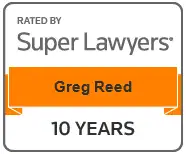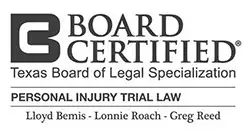Can I get disability benefits if I am suffering from the effects of Burns?
A disability lawyer’s advice on qualifying for assistance due to the effects of burns.
Author Attorney Greg Reed:
Summary: Can I get disability benefits if I am suffering from the effects of burns?
First you must meet the SSA’s financial requirement: You must have worked long enough, recently enough, and not made over a predetermined level of income.
Second you must meet the medical requirements:
The Social Security Administration recognizes burns as an impairment in its Blue Book, but whether or not an applicant is approved for disability benefits depends on the area of the body burned and the severity.
Burns are mentioned in both Sections 1.00 Musculoskeletal System and 8.00 Skin Disorders.
In order to qualify for disability under these listings, an applicant must provide medical evidence that:
Skin lesions caused by burns do not allow the applicant to perform their job; and the effects of the burns on the body and body functions are expected to last more than 12 months.
Additionally, to qualify under Listing 1.08, an applicant must be undergoing treatment by a surgeon to restore or preserve functional use of the burned area.
If an applicant does not meet the criteria of a listing, they may still qualify if their functional limitations prevent them from working.
Burns are one of the most common injuries experienced by adults and children. Although most people recover quickly, some burns are so severe they limit a person’s day to day activities and cause serious health consequences.

The Social Security Administration recognizes burns as an impairment in its Blue Book, but whether or not an applicant is approved for disability benefits depends on the area of the body burned and the severity. Burns are mentioned in both Sections 1.00 and 8.00:
Burns can be caused by:
- Hot, boiling liquids
- Fires (including matches, candles, and lighters)
- Chemicals
- Excessive sun exposure
Burns are characterized as first, second or third degree, based on the level of damage.
First degree burns affect only the outer layer of skin, the epidermis. The skin appears red, but does not blister and sheds off as the burn heals. Usually, first degree burns heal in 7-10 days.
Second degree burns affect the first layer of skin and the second layer, the dermis.
The skin blisters, and there is some thickening of the skin. Second degree burns may cause scarring and often the skin pigment changes. Most second-degree burns heal in 2-3 weeks.
Third degree burns extend through all layers of the skin and are the most serious.
These burns result in thickness of the skin and may have a charred appearance or dark brown color. Although third-degree burns are the most severe, they may not be the most painful because they can cause nerve damage. Without surgery, these burns may heal with scarring and muscle contracture.
All burns can become infected, but third-degree burns are at the most risk for complications.
Among the problems which may develop are:
- Blood loss
- Shock
- Tetanus (a bacterial infection that affects the nervous system)
- Hypothermia (low body temperature caused by excessive loss of body heat)
- Hypovolemia (low blood volume)
- Breathing problems from hot air or smoke
- Bone and joint problems caused by shortening and tightening of muscles and tendons
These or a combination of these symptoms can cause you to miss work and jeopardize your ability to maintain employment.
Burns and Qualifying for Disability Benefits.
Burns can cause a person to lose the ability to perform daily functions and prevent them from working.
The Social Security Administration recognizes burns as an impairment in its Blue Book, but whether or not an applicant is approved for disability benefits depends on the area of the body burned and the severity. Burns are mentioned in both Sections 1.00 and 8.00:
1.0 Musculoskeletal System
- Disorders of the musculoskeletal system
- Loss of function.
-
General. Under this section, loss of function may be due to bone or joint deformity or destruction from any cause; miscellaneous disorders of the spine with or without radiculopathy or other neurological deficits; amputation; or fractures or soft tissue injuries, including burns, requiring prolonged periods of immobility or convalescence. The provisions of 1.02 and 1.03 notwithstanding, inflammatory arthritis is evaluated under 14.09 (see 14.00D6). Impairments with neurological causes are to be evaluated under 11.00ff. - Skin lesions caused by burns do not allow the applicant to perform their job; and
- The effects of the burns on the body and body functions are expected to last more than 12 months.
- The Duration of Work test. Whether you have worked long enough to be covered under SSDI.
- The Current Work Test. Whether you worked recently enough for the work to actually count toward coverage.
- Are you working? Your disability must be “total”.
- Is your medical condition severe? Your disability must be “severe” enough to interfere with your ability to perform basic work-related activities, such as walking, sitting, and remembering.
- Is your medical condition on the List of Impairments? The SSA has a “List of Impairments” that automatically qualify as “severe” disabilities. If your disease is not listed this does not mean you cannot get disability, it means you must prove you cannot maintain employment due to your limitations.
- Can you do the work you did before? SSDI rules look at whether your medical condition prevents you from doing the work you did prior to developing the condition.
- Can you do any other type of work? If you cannot do your prior work, an evaluation is made as to whether you can perform any other kind of work.
These may result from hereditary, congenital, or acquired pathologic processes. Impairments may result from infectious, inflammatory, or degenerative processes, traumatic or developmental events, or neoplastic, vascular, or toxic/metabolic diseases.
1.08 Soft tissue injury (e.g., burns) of an upper or lower extremity, trunk, or face and head, under continuing surgical management, as defined in 1.00M, directed toward the salvage or restoration of major function, and such major function was not restored or expected to be restored within 12 months of onset.
Major function of the face and head is described in 1.00.
8.00 Skin Disorders
A. What skin disorders do we evaluate with these listings?
We use these listings to evaluate skin disorders that may result from hereditary, congenital, or acquired pathological processes. The kinds of impairments covered by these listings are: Ichthyosis, bullous diseases, chronic infections of the skin or mucous membranes, dermatitis, hidradenitis suppurativa, genetic photosensitivity disorders, and burns.
F. How do we evaluate burns?
Electrical, chemical, or thermal burns frequently affect other body systems; for example, musculoskeletal, special senses and speech, respiratory, cardiovascular, renal, neurological, or mental. Consequently, we evaluate burns the way we evaluate other disorders that can affect the skin and other body systems, using the listing for the predominant feature of your impairment. For example, if your soft tissue injuries are under continuing surgical management (as defined in 1.00M), we will evaluate your impairment under 1.08. However, if your burns do not meet the requirements of 1.08 and you have extensive skin lesions that result in a very serious limitation (as defined in 8.00C1) that has lasted or can be expected to last for a continuous period of at least 12 months, we will evaluate them under 8.08.
8.08 Burns, with extensive skin lesions that have lasted or can be expected to last for a continuous period of at least 12 months (see 8.00F).
In order to qualify for disability under these listings, an applicant must provide medical evidence that:

Texas Social Security Disability Lawyers Bemis, Roach & Reed. Protecting the Disabled since 1993.
Additionally, to qualify under Listing 1.08, an applicant must be undergoing treatment by a surgeon to restore or preserve functional use of the burned area.
This includes recovering from any complications resulting from treatment such as infection.
Any medical evidence provided by an applicant’s doctor should describe the burns and detail activities an applicant is prevented from doing, treatments given and the patient’s response to those treatments, and state that the effects will continue for more than 12 months.
If an applicant does not meet the criteria of a listing, they may still qualify if their functional limitations prevent them from working. Burns can result in decreased strength and range of motion limiting a person’s ability to perform any number of physical tasks such as lifting, pulling, pushing, carrying items, walking, standing or sitting.
You may be eligible for disability benefits if you have burns that may take more than a year to heal.
In order to qualify for Social Security Disability, you will need to satisfy a few specific requirements in two categories as determined by the Social Security Administration.
The first category is the Work Requirements which has two tests.
The second category is the Medical Eligibility Requirement.
More details can be found on our Qualifying for Disability page.
Disability benefits are an important source of income for those who are unable to work. If you not able to work due to accident or illness, you may be eligible for Social Security Disability or Long Term Disability benefits. If you have applied for benefits and been denied, contact the attorneys at Bemis, Roach and Reed for a FREE consultation. Call 512-454-4000 and get help NOW.
Try these links for further reading on this subject:
How is my disability assessed if I have Multiple Impairments?
Residual Functional Capacity and qualifying for Social Security Disability Benefits
Can you get disability for skin cancer?
Author: Attorney Greg Reed has been practicing law for 29 years. He is Superlawyers rated by Thomson Reuters and is Top AV Preeminent® and Client Champion Gold rated by Martindale Hubbell. Through his extensive litigation Mr. Reed obtained board certification from the Texas Board of Legal Specialization. Greg is admitted to practice in the United States District Court - all Texas Districts and the United States Court of Appeals-Fifth Circuit. Mr. Reed is a member of the Travis County Bar Association, Texas Trial Lawyers Association, past Director of the Capital Area Trial Lawyers Association, and an Associate member of the American Board of Trial Advocates. Mr. Reed and all the members of Bemis, Roach & Reed have been active participants in the Travis County Lawyer referral service.
Your Free Initial Consultation
Call now:
At Bemis, Roach and Reed, if we can't help you, we will try to find the right attorneys for you.
We offer each of our prospective clients a free no obligation one hour phone or office consultation to see if we can help you and if you are comfortable with us. We know how difficult a time like this can be and how hard the decisions are. If we can be of assistance to you and help you find a solution to your issue we will, even if that means referring you to another attorney.
Let's get you Started:
If you could provide us with some basic information about your claim we will get right back with you with a free case evaluation and schedule your Free Consultation Today.
You can also email us at: contact@brrlaw.com
Kind Words from Our Clients
“The attorneys and staff at Bemis, Roach & Reed have provided me and my husband, Jeff, with stellar advice, care, and service. They made navigating the SSDI process easy, painless, and as timely as possible. During this difficult time in our lives it was a tremendous relief to know they were on our side and keeping us updated on next steps and timelines. We also had questions about my husband’s long term disability insurance and they helped us get those questions answered and resolved without any additional fee. I highly recommend Bemis, Roach & Reed.” – Kelli G
“I needed a lawyer for my case and had googled best lawyers. They came up first on my list and decided to give them a call. From the moment I called I knew I chose the right people. They said they would fight for me and fight they did. They knew what they were doing and kept good communication throughout the process. If you need someone that will listen, understand, and fight then these are the people. HIGHLY RECOMMEND.” – Marcel L.
“I’ve had a great experience working with Bemis, Roach & Reed for my disability case. I spent two years fighting on my own, until I was informed to look for a disability lawyer. Right away, sending in questions was a breeze, and from the moment my case was accepted, everything became a major weight off my shoulders. My newest appeal was filed for me, my medical records and case history sorted for me, and I could finally focus on my appointments and treatment with a little less worry. Everything was explained to me in a way that made sense, the process was set out in an easy to understand way. And, just like that, at the beginning of July 2023, my claim was accepted!” – Sunshinemutt








